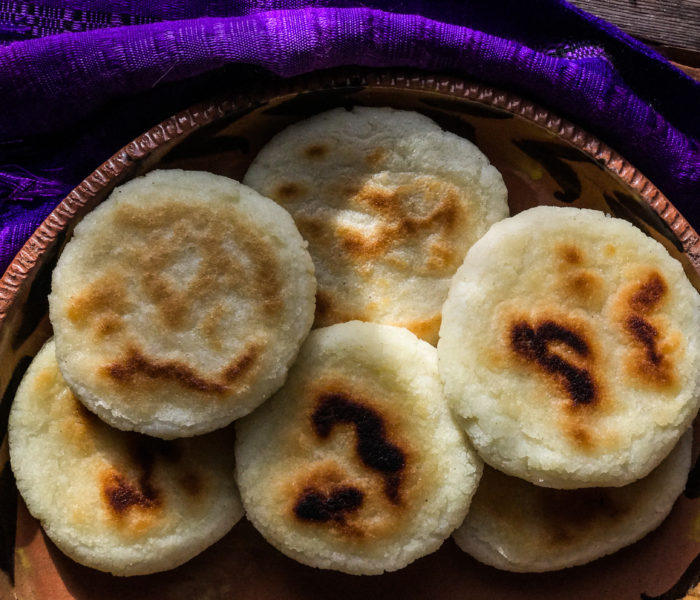Hola Mi Gente,
Let me paint you a picture of my Sunday Mornings growing up:
We would be listening to Ricardo Arjona–Guatemala’s prize musical jewel; half dancing, half sweeping (because on Sundays we cleaned the house)–the smells of the week’s leftovers filling the house. If it was spring or summertime, my sister and I would get sent to the garden outside the house to get some fresh herbs or vegetables for a salad, and my mom would be making Arepas.
Arepas. The first meal a Venezuelan friend brought my mom to the hospital after she had me. My first earthly feast. My first favorite brunch food. Before brunch was even a thing, my mom was killing the Sunday morning brunch scene with a table of endless spreads. Refried beans, little bits of queso fresco, scrambled eggs with fresh bell pepper, tomatoes, and onions. Any and all of these things would go nestled into a warm arepa, with a little bit of butter, and we would eat until it was all gone. We were full until dinner, sometimes beyond.
I remember one time I was at a friends’ house and they asked me if I had a feast every morning when I woke up. And while it wasn’t always, it WAS often enough that I proudly beamed yes, as I went on to elaborate the different spreads I had throughout the week–Arepas always my clear favorite.
Arepas were the first meal I ate with Ben and my mom. Our first year of dating, Ben helped my mom sneak into my house early in the morning (she lived 3 hours away from our college town), and make us all arepas for my birthday.
If it seems like I’m sentimental about arepas, it’s because I am. They have always been a form of I-Love-You from my mom. My mom who gave me the gift of loving my people through food. And she got it from her mother. Who probably got it from hers. And then you throw in our Venezuelan friends, who probably learned to make arepas from the generations before them, the inseams of my mother’s love for me, is the love of cross-cultural abuelas who passed on their own kind of love for their people.
To be fair to everyone around the table, Arepas don’t just belong to Venezuela. Colombia makes arepas, too. Delicious arepas. I just learned to make them the Venezuelan way, stuffed with any savory thing you have around. I say savory, because I can’t think of anything that wouldn’t go well in an arepa that is savory: leftover chicken, beans, avocado, bacon, cheese, butter, steak, greens, tomatoes. But I might chase and hunt you down if you ever tried to make them a dessert.
What makes arepas different from tortillas or other corn goods?
I’m glad you asked. Arepa corn meal is pre-cooked, and a little more coarse than masa, the corn flour used to make tortillas and the like. The texture and flavor profile is different, and the arepa meal rises more than regular corn masa. This is another great example of how Latin America thrives at taking one ingredient and making it different in every country and culture. You can usually find arepa mix (my favorite it harina PAN) at the grocery store in the Latin American section, get it off amazon (through the link above), or adventure out to your local grocery store to find it. Just let them know you’re making arepas, and they’ll point you in the right direction.
As an added plus, arepa meal is Gluten Free and Dairy Free. I guess that’s another thing you could say about mi gente Latina–we’ve always been early to the trendy party. You can make arepas vegan or stuffed with meat. You can melt cheese in them, or just slice in an avocado. It’s really up to you and your fridge how you want to enjoy them. I personally always love a simple arepa with some mozzarella and queso fresco. If you pop them in the oven after filling with cheese, it melts beautifully and makes it all the better.
However you choose to enjoy these, I hope you fill the making of them with a lot of love!













Love, love, love,

Shop This Post

Arepas
Ingredients
- 2 C Arepa PAN Flour
- 1 TSP Salt
- 1 TBSP Oil I use avocado oil, plus more for cooking
- 2 1/4 C Water
Instructions
- In a large bowl, combine all ingredients, mix together until you have a smooth dough. Wash your hands (you're going to want your hands to be clean after kneading the dough to make sure you have the right consistency), and let the dough rest for 5 minutes. Your dough should be smooth, and not stick to your hands. A good way to test if it is ready, is to roll into a ball and flatten--if the edges of the arepa crack, it needs a little more water. If it sticks to your hands easily, add a little more flour and knead again.
- Once your dough is at the right consistency, roll into six balls and flatten into disks that are about 1/2" thick. Brush with a little oil on both sides.
- Head an electric skillet OR a large cast iron pan over medium high heat, with enough oil to cover the bottom of the pan. Add in the disks and cook for 6-8 minutes on each side, or until golden brown on each side, but not burnt. Remove from heat, cool for 5 minutes, and then slice and fill with whatever you like!



